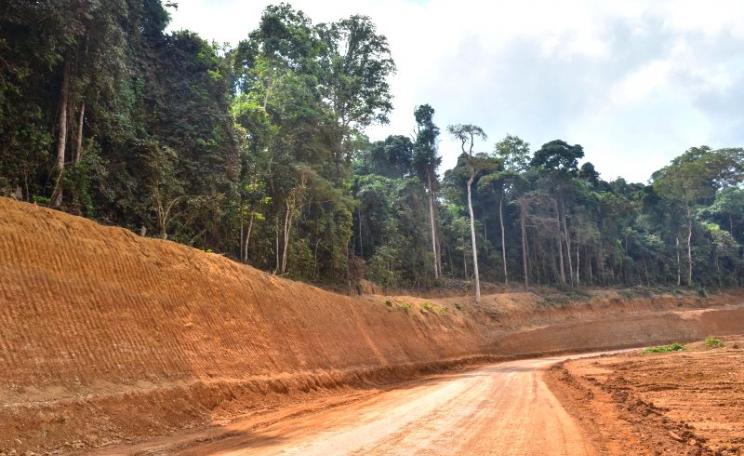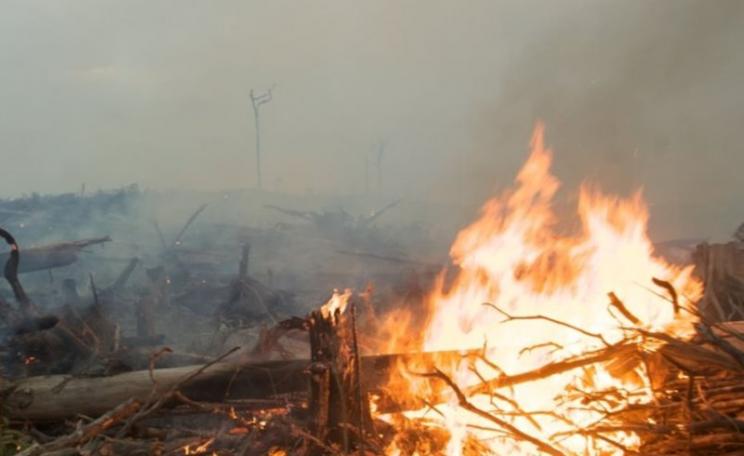Protecting the elephant also harbors habitat for many smaller animals, including endangered primates such as the black-shanked douc, Germain's silvered langur, and yellow-cheeked crested gibbon, among many others.
Among many, Cambodia is best known for its bitter conflicts-the incursions from US bombing during the Vietnam War, its numerous civil clashes, and the unbridled horrors of its Killing Fields.
The Kingdom of Cambodia today is vastly different, a relatively calm land where the economy is growing at a vigorous 7% per year.
But an important new battle is being fought here: one between the forces of economic development, avarice, and corruption on the one hand, and nature conservation, indigenous peoples, and rural communities on the other.
Nowhere is the conflict between 'development' and 'nature' more evident than in northeastern Cambodia, in the Annamite Mountains where Mondulkiri Province adjoins Vietnam.
There, some of Cambodia's biologically richest forests are under assault - from legal and illegal loggers, industrial rubber and pine plantations, and slash-and-burn farming from immigrants and a growing indigenous populace.
I reached Mondulkiri with my wife and two children after a liver-jolting seven-hour drive from Phnom Penh, the national capital. The driver of our van drove like a man possessed, honking madly at the thousands of small motorcycles that crowded the road.
Elephant Valley - first the elephants, then the visitors
A single motorcycle can bear an entire family, or an astonishing burden of goods. Some had pigs lashed to the back; one motorcycle had at least two hundred live chickens hanging upside down from a series of scaffolds. Along the way we passed a kaleidoscope of rural life-villages; rice, pepper, and manioc farms; industrial plantations; slash-and-burn farming plots.
We eventually reached our destination, a place known as Elephant Valley. Now one of Cambodia's better-known ecotourism destinations, it was initiated in 2007 by Jack Highwood, a self-described 'mad Englishman'.
At the age of 18, Highwood took a break from his university studies in archaeology to travel to Thailand. There, a friend's uncle arranged for him to work as a 'mahout' - a carer for domesticated elephants. Jack was bitten by the elephant bug. He gave up his nascent career in archaeology to return to Thailand, to dedicate his life to saving oppressed elephants.
Jack's initial focus was on domesticated elephants - typically captured from the wild at four to five years of age, starved and beaten into submission, and then trained for a variety of purposes, such as carrying or dragging timber for logging operations, ferrying tourists or poachers, or lugging heavy cargo.
Highly lucrative for their owners, many domesticated elephants were heavily overworked and psychologically scarred. Some were literally worked to death.
For Jack, Mondulkiri Province in Cambodia seemed like a prime place to work. It had forests in abundance and scores of working domesticated elephants, many in poor health. He set up a pub in the small township of Sen Monorom; back then, the town - once ground-zero for US bombers striving to stem the flow of Viet Cong arms southward along the Ho Chi Minh trail - had no pub.
Protecting the elephant also harbors habitat for many smaller animals, including endangered primates such as the black-shanked douc, Germain's silvered langur, and yellow-cheeked crested gibbon, among many others.
And then Jack started rescuing elephants, cajoling or paying their owners to give them downtime to rest, and working to build up a reserve of sorts - Elephant Valley - that quickly began to attract visitors.
By the time we visited Elephant Valley, in April of 2015, it had grown from a humane project for elephants into a small but thriving ecotourism, conservation, and community-outreach venture.
Elephant Valley now spans 1,600 hectares and sustains a rustic but comfortable lodge and guesthouses, plus offices in nearby Sen Monoram. Visitors are greeted by a Marmaduke-sized dog called Zerax, which helps to keep kitchen-raiding macaques at bay, and a charming little cat known as Captain Meow.
Visitors to Elephant Valley get their money's worth. In two days there, we spent some eight hours hiking through rainforests with guides and interacting closely with elephants, and more time birdwatching and spotlighting for wildlife at night. We learned about the history of each elephant, and saw how many had collapsed ribs or bent backs or deep scars from overwork. One had been blinded in one eye by the hooked pole of its mahout.
Although they were relearning the complex social behaviors and foraging strategies of wild elephants, most of the behemoths were relaxed around us. A couple even wandered up to nudge us gently with their trunks.
A critical buffer zone for a vital forest reserve
Were it just a small ecotourism operation, Elephant Valley would be unremarkable - but it is much more than that. For one thing, it forms a critical buffer zone for the northern flank of Seima Protection Forest, one of Cambodia's most important wildlife and indigenous reserves.
Seima is 3,000 square kilometers in area but is being squeezed on all sides. Wildlife populations, including several critically endangered primate, bird, and reptile species, are suffering staggering losses from deforestation and poaching.
Today, northeastern Cambodia is one of the country's most critical refuges for wildlife, but it is a refuge in retreat. Tigers may now be extinct throughout Cambodia. Forests and grasslands to the north of Seima once sustained massive annual migrations of elephants, wild water buffaloes, gaur (a species of wild cow), and other ungulates-and was widely known as the 'Serengeti of Indochina'.
Today, those great herds and migrations have largely vanished. Some perished from US carpet bombing; in those days, elephants, which could be used to ferry arms, were considered legitimate targets. After the war, Soldier of Fortune Magazine sponsored a major wildlife hunt in the region. The trophies included a handful of elephants and four tigers.
Although the shattering din of exploding bombs has long faded away, defending the likes of Elephant Valley is still no small feat. Highwood employs five full-time forest rangers-riding motorcycles and armed with AK-47 machine-guns - to defend this patch of forest. The Wildlife Conservation Society, a New York-headquartered NGO, and the Cambodian Forest Administration contribute to this enforcement effort.
During the night we spent there, we heard several rifle shots in the distance, from poachers using spotlights. By dinnertime, scores of nearby forest fires had created a perversely beautiful, blood-red sunset. On our final evening, Highwood and I came upon two timber thieves, and he threw a sharp curse at them - he's fluent in the Khmer language spoken in Cambodia - while snapping their photos.
An endangered paradise
Because he is such a staunch defender of nature, Highwood has endeared himself to the 70-odd members of the Wildlife Conservation Society who work in Cambodia. "He's not a big guy, but he has a lion-like presence and keen intelligence", said Alex Diment, a WCS researcher.
"His efforts at Elephant Valley are hugely important for helping to protect the northern end of Seima Protection Forest - a place we're working desperately, in concert with the Cambodian Forest Administration, to save."
Among the more agonizing choices being faced by WCS is whether or not to support a proposal by the German Development Bank to pave a road through the heart of Seima Protection Forest. A dirt road already exists to service indigenous villages scattered though the forest, but it becomes boggy and nearly impassable during the wet season.
"We don't want a paved road, as that could sharply increase illegal logging and poaching, but at least the German Bank would work with us to limit its impacts", said Diment. "And if they don't do it, we think the road would get built anyway by a Chinese firm, which are notorious for being little worried about environmental and social concerns."
Nonetheless, Jack Highwood doesn't like the German proposal. "They should just pave a one-meter-wide strip along the road, wide enough for motorcycles but not logging trucks or other vehicles", he said.
Community support - both ways
For all the appreciation he's received from conservationists, Highwood is perhaps even more admired by the indigenous hill-tribes in the area. "Jack is really responsible for kick-starting ecotourism in Mondulkuri Province", said Kez Hobson, another WCS-Cambodia researcher. "And that's a growing source of income for the indigenous people and other residents."
Clearly, Highland believes fervently in supporting community development. Among Elephant Valley's many outreach programs is payments for low-income families to keep their children in school, rather than sending them into the fields to work. Each month, a family receives one kilogram of rice for every day that their child has attended school; not surprisingly, school attendance among the children of poor families has risen dramatically.
Another key initiative is medical support. Elephant Valley supports a range of medical services, including supplying the local medical clinic and augmenting the salaries of its overworked nurses. One artifact of this help is that rates of child mortality have declined in recent years.
Given that the local inhabitants typically have five or six children, I asked Highwood if he wasn't worried about inadvertently contributing to local overpopulation and thereby increasing environmental pressures. He just laughed.
"Last month I signed a cheque for 18,000 condoms", he said. The condoms are distributed freely; three large bowls in Sen Monoram are kept full of condoms, and anyone who wants some can just come and take them.
At times, one worries that the burden of supporting Elephant Valley is taking a heavy toll on Jack Highwood. He is often woken in the middle of the night to drive a local resident to hospital, or to capture an escaped elephant marauding a neighbor's banana farm.
One day he heard that one of his employees, a local woman who was raising five kids alone, had been reduced to eating dirt in order to keep her kids fed. He immediately drove a vanload of food over to her house. And because he resolutely refuses to pay bribes in Cambodia - consistently ranked as one of the world's most corrupt nations - he drowns in mundane paperwork. Most simply pay off a local official to 'facilitate' their bureaucratic hurdles.
Conserving elephants also saves forest, primates, indigenous communities
In Cambodia today, indigenous peoples are very much at the mercy of the government. Although they have lived on their traditional lands for centuries, they rarely have formal land rights. The government is selling off large tracts of their land to industrial loggers and for large-scale rubber and pine plantations.
Often the villagers have no idea that this has happened until the bulldozers arrive at their doorstep. Despite protests from international groups such as Global Witness, the land grabs continue apace.
It is in this wild frontier that places such as Seima Protection Forest and Elephant Valley provide a final refuge for beleaguered species and peoples. And because the elephant is such a large, wide-ranging animal, it is an 'umbrella' species: protecting it also harbors habitat for many smaller animals, including endangered primates such as the black-shanked douc, Germain's silvered langur, and yellow-cheeked crested gibbon, among many others.
In the fraught battle to save Cambodia's surviving forests and indigenous groups, places like Elephant Valley are providing a model for integrating nature conservation with indigenous community rights and international ecotourism.
Such efforts will have a fighting chance so long as fiercely dedicated people like Jack Highwood are willing to work so hard to see them succeed.
Visit Elephant Valley.
William Laurance is a distinguished research professor and Australian Laureate at James Cook University in Cairns, Australia. He recently received the Zoological Society of London's Outstanding Contributions to Conservation Award.







